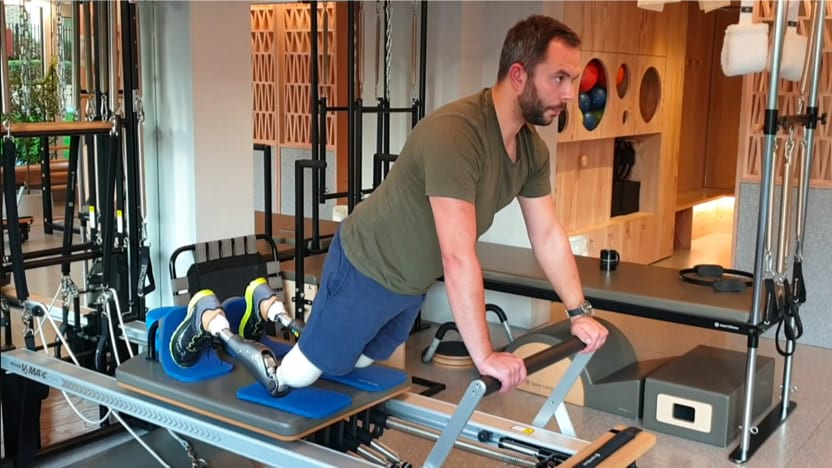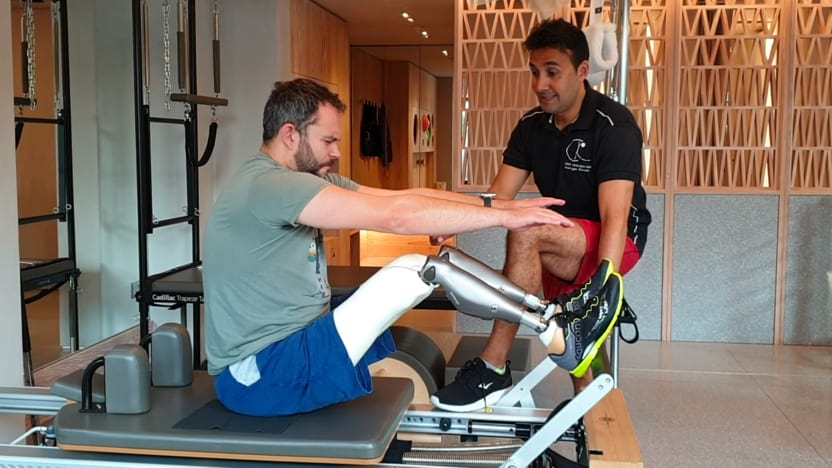In this new blog series, we’ll be following STOTT PILATES® Certified Instructor Carlo Yanez as he guides his client Alex Dainty, a 28-year-old double amputee, on an inspirational rehab journey.
The human body can do remarkable things, but every client has their limits. In order to build trust, respect personal boundaries and navigate setbacks in the studio, instructors need to determine when they can keep pushing their client and when they need to pause or regress the program.
For Carlo Yanez, a STOTT PILATES® Certified Instructor and owner of boutique Pilates studio, Core Kensington in London, England, and his client Alex Dainty, a double amputee, figuring out where that line was drawn helped them form a successful partnership over the last year.
“Carlo’s a hard taskmaster. He pushes me an awful lot, which is good because I’m a bit whingy and I’ll often take the easy way out if I’m not pushed to do something, but he’s also super receptive to me putting my foot down and saying, ‘No, this isn’t working for me, we need to find a different way of doing this,’” Alex says.

In 2012, Alex, 28, was hit by a drunk driver and had both his legs amputated through the knee. He learned how to walk on short, single-joint prosthetics, but since they have greater wear and tear on the joints in the long term, he turned to Carlo and his expertise in STOTT PILATES, rehab and osteopathy to help him transition to his long prosthetics.
The task was daunting, but Carlo embraced the challenge, creating a modified STOTT PILATES program that would retrain Alex’s deep core stabilizers and improve his lumbar flexion.
“My main focus was on building Alex’s strength and stability in his core and trunk muscles, including his shoulder girdle, and his glutes and hamstrings. In short, everything that would help improve his gait on his long prosthetics. We worked in as many positions as possible, including supine, prone, kneeling, standing, side-lying, anything to improve his spinal mobility and flexion,” Carlo says.
They began working together over a year ago, and during that time, Carlo has become better at reading Alex’s mood and motivation levels.
“The client’s emotions, body awareness and the way they feel that day are crucial to the success of the session. Maybe they had a bad night’s sleep, or didn’t get enough to eat beforehand, all those things can affect how someone moves and connects with their body, adding another layer of challenge.
“Some days I had to regress Alex’s program or find an alternative way for him to do it; other days, I could double the tension and ramp up the progressions.”
Figuring out how to modify the exercises to make them more comfortable, accommodating and effective for Alex was also a learning curve, Carlo says.
“The modifications you’re taught are designed for people who don’t have disabilities, so you have to get creative. Not only do you have to account for his legs not being present, but also for the adaptations his body has made over time as a result of that, and the discomfort that the prosthetic legs can cause in certain positions or movements.”

This is where the Merrithew® equipment played a major role in supporting the exercises, Carlo says.
“For example, we used the Jumpboard for footwork instead of the regular Reformer footbar because it put Alex’s legs in a better angle. Having those options made it a lot easier to adjust the programming to suit his needs.”
Carlo also uses the Rehab V2 Max™ Reformer, which at 22-inches is six inches higher off the ground than the standard V2 Max Reformer, making it more accessible for rehab clients with mobility issues.
“Working with prosthetics can be insanely frustrating because they don’t always do what I want them to do when I want them to do it. Carlo is good at identifying when I’m being a little bit of a brat or when it’s really pissing me off and causing great frustration,” Alex says.
“My rehab a very physical thing, sometimes there’s room to push me and sometimes we just have to roll it back, and return to an exercise I know I can do to rebuild my confidence and belief in myself— and then we try again.”
Despite those challenges and frustrations, Alex still thinks Pilates has been worth the effort. “The improvements are not always obvious, or as easy to identify as say lifting heavy weights at the gym, but I feel the differences in my body, in how I move and hold myself,” Alex says.
“I recommend Pilates to everyone, not just amputees.”
Read more about Carlo and Alex in our first blog post in this series.